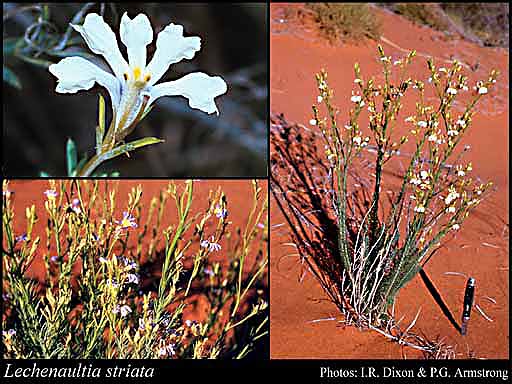- Reference
- Fragm. (Mueller) 8:245-246 (1874)
- Conservation Code
- Not threatened
- Naturalised Status
- Native to Western Australia
- Name Status
- Current
Virgate, ascending, sparsely branched perennial, herb or shrub, 0.15-0.6 m high. Fl. blue/yellow-cream, Jun to Nov. Red sand. Sand dunes.

Scientific Description
Stems ribbed. Leaves flat, 4-20 mm long, 0.5-0.6 mm wide, Indumentum absent (leaves glabrous); margins entire. Bracteoles absent. Pedicel pedicellate, Pedicel length the pedicels 7-11 mm long, glabrous. Calyx lobes present, Calyx length 4-7.5 mm long, glabrous. Corolla white or yellow, 16-18 mm long, without auricles, not spurred, glabrous on the outside, hairy on the inside; central lobes 6-6.5 mm long, with wings; outer lobes 7-8 mm long, wings present on both sides, 0.8-1 mm wide. Anthers free. Ovary inferior, not gibbose; style 8-10 mm long, hairy; indusium single, hairy; ovules more than two. Flowers in June, July, August, September, October and November. Occurs in the Murchison (MUR), Great Victoria Desert (GVD), Central Ranges (CR), Gibson Desert (GD), Great Sandy Desert (GSD) and Little Sandy Desert(LSD) IBRA Region(s), of the Eremaean (E) Botanical Province.
Distribution
- IBRA Regions
- Central Ranges, Gibson Desert, Great Sandy Desert, Great Victoria Desert, Little Sandy Desert, Murchison.
- IBRA Subregions
- Central, Eastern Murchison, Lateritic Plain, Mackay, Mann-Musgrave Block, Shield, Trainor.
- Local Government Areas (LGAs)
- East Pilbara, Kalgoorlie-Boulder, Laverton, Menzies, Ngaanyatjarraku, Wiluna.